How Weather Affects over Time the Repeatability of Spectral Indices Used for Geological Remote Sensing
Abstract
1. Introduction
2. Materials and Methods
3. Results
3.1. Observed Weather Conditions
3.2. Image Processing Results
3.3. Indices over Time
3.4. Vegetation Time Series
3.5. Geological Time Series
4. Discussion
5. Conclusions
Author Contributions
Funding
Data Availability Statement
Conflicts of Interest
Abbreviations
| ASTER | Advanced Spaceborne Thermal Emission and Reflection Radiometer |
| ESA | European Space Agency |
| GEE | Google Earth Engine |
| GLDAS | Global Land Data Assimilation System |
| MSI | MultiSpectral Instrument |
| MSS | MultiSpectral Scanner |
| NDVI | Normalized Difference Vegetation Index |
| NIR | Near InfraRed |
| SCL | Scene Classification Layer |
| SWIR | ShortWave InfraRed |
| TM | Thematic Mapper |
| VNIR | Visible & Near InfraRed |
References
- Cooper, B.L.; Salisbury, J.W.; Killen, R.M.; Potter, A.E. Midinfrared spectral features of rocks and their powders. J. Geophys. Res.-Planets 2002, 107. [Google Scholar] [CrossRef]
- Salisbury, J.W.; Walter, L.S.; Vergo, N. Availability of a library of infrared (2.1–25.0 μm) mineral spectra. Am. Mineral. 1989, 74, 938–939. [Google Scholar]
- Hunt, G. Spectral signatures of particulate minerals in the visible and near-infrared. Geophysics 1977, 42, 501–513. [Google Scholar] [CrossRef]
- Goetz, A.; Rowan, L. Geologic remote-sensing. Science 1981, 211, 781–791. [Google Scholar] [CrossRef]
- Crósta, A.; Moore, J. Geological mapping using Landsat Thematic Mapper imagery in Almeria Province, south-east Spain. Int. J. Remote Sens. 1989, 10, 505–512. [Google Scholar] [CrossRef]
- Abrams, M. The Advanced Spaceborne Thermal Emission and Reflection Radiometer (ASTER): Data products for the high spatial resolution imager on NASA’s Terra platform. Int. J. Remote Sens. 2000, 21, 847–859. [Google Scholar] [CrossRef]
- Yamaguchi, Y.; Kahle, A.B.; Tsu, H.; Kawakami, T.; Pniel, M. Overview of Advanced Spaceborne Thermal Emission and Reflection Radiometer (ASTER). IEEE Trans. Geosci. Remote Sens. 1998, 36, 1062–1071. [Google Scholar] [CrossRef]
- Abrams, M.; Hook, S.J. Simulated ASTER data for geologic studies. IEEE Trans. Geosci. Remote Sens. 1995, 33, 692–699. [Google Scholar] [CrossRef]
- Hewson, R.; Robson, D.; Mauger, A.; Cudahy, T.; Thomas, M.; Jones, S. Using the Geoscience Australia-CSIRO ASTER maps and airborne geophysics to explore Australian geoscience. J. Spat. Sci. 2015, 60, 207–231. [Google Scholar] [CrossRef]
- Cudahy, T. Australian ASTER Geoscience Product Notes; Technical Report; Commonwealth Scientific and Industrial Research Organisation (CSIRO): Canberra, Australia, 2012. [Google Scholar] [CrossRef]
- Wilford, J.; Roberts, D. Enhanced Bare Earth Covariates for Soil and Lithological Modelling. Version 1.0. Terrestrial Ecosystem Research Network. Dataset. 2021. Available online: https://portal.tern.org.au/enhanced-bare-earth-lithological-modelling/21910 (accessed on 18 November 2022).
- Roberts, D.; Wilford, J.; Ghattas, O. Exposed soil and mineral map of the Australian continent revealing the land at its barest. Nat. Commun. 2019, 10, 11. [Google Scholar] [CrossRef]
- Hewson, R.; van der Werff, H.; Hecker, C.; van Ruitenbeek, F.; Bakker, W.; van der Meijde, M. Status and Developments in Geological Remote Sensing. FastTIMES 2020, 25, 54–66. [Google Scholar]
- Soydan, H.; Koz, A.; Şebnem Düzgün, H. Secondary Iron Mineral Detection via Hyperspectral Unmixing Analysis with Sentinel-2 Imagery. Int. J. Appl. Earth Obs. Geoinf. 2021, 101, 102343. [Google Scholar] [CrossRef]
- van der Werff, H.; van der Meer, F. Sentinel-2A MSI and Landsat 8 OLI Provide Data Continuity for Geological Remote Sensing. Remote Sens. 2016, 8, 883. [Google Scholar] [CrossRef]
- van der Werff, H.; van der Meer, F. Sentinel-2 for mapping iron absorption feature parameters. Remote Sens. 2015, 7, 12635–12653. [Google Scholar] [CrossRef]
- van der Meer, F.; van der Werff, H.; van Ruitenbeek, F. Potential of ESA’s Sentinel-2 for geological applications. Remote Sens. Environ. 2014, 148, 124–133. [Google Scholar] [CrossRef]
- Mielke, C.; Boesche, N.; Rogass, C.; Kaufmann, H.; Gauert, C.; de Wit, M. Spaceborne Mine Waste Mineralogy Monitoring in South Africa, Applications for Modern Push-Broom Missions: Hyperion/OLI and EnMAP/Sentinel-2. Remote Sens. 2014, 6, 6790–6816. [Google Scholar] [CrossRef]
- Wilford, J.; Roberts, D. Sentinel-2 Barest Earth Imagery for Soil and Lithological Mapping; Geoscience: Canberra, Australia, 2021. [Google Scholar] [CrossRef]
- Rowan, L.C.; Mars, J.C. Lithologic mapping in the Mountain Pass, California area using Advanced Spaceborne Thermal Emission and Reflection Radiometer (ASTER) data. Remote Sens. Environ. 2003, 84, 350–366. [Google Scholar] [CrossRef]
- Cudahy, T.; Caccetta, M.; Thomas, M.; Hewson, R.; Abrams, M.; Kato, M.; Kashimura, O.; Ninomiya, Y.; Yamaguchi, Y.; Collings, S.; et al. Satellite-derived mineral mapping and monitoring of weathering, deposition and erosion. Sci. Rep. 2016, 6, 23702. [Google Scholar] [CrossRef]
- van der Meer, F.; van der Werff, H.; van Ruitenbeek, F.; Hecker, C.; Bakker, W.; Noomen, M.; van der Meijde, M.; Carranza, E.; de Smeth, J.; Woldai, T. Multi- and hyperspectral geologic remote sensing: A review. Int. J. Appl. Earth Obs. Geoinf. 2012, 14, 112–128. [Google Scholar] [CrossRef]
- van der Werff, H.; Hewson, R.; van der Meer, F. Use What Is There: What Can Sentinel-2 Do for Geological Remote Sensing? In Proceedings of the IGARSS 2018—2018 IEEE International Geoscience and Remote Sensing Symposium, Valencia, Spain, 22–27 July 2018; IEEE: Valencia, Spain, 2018. [Google Scholar] [CrossRef]
- Langford, R.L. Temporal merging of remote sensing data to enhance spectral regolith, lithological and alteration patterns for regional mineral exploration. Ore Geol. Rev. 2015, 68, 14–29. [Google Scholar] [CrossRef]
- Gorelick, N.; Hancher, M.; Dixon, M.; Ilyushchenko, S.; Thau, D.; Moore, R. Google Earth Engine: Planetary-scale geospatial analysis for everyone. Remote Sens. Environ. 2017, 202, 18–27. [Google Scholar] [CrossRef]
- Beaudoing, H.; Rodell, M. GLDAS Noah Land Surface Model L4 3 Hourly 0.25 × 0.25 Degree V2.1. 2020. Available online: https://disc.gsfc.nasa.gov/datasets/GLDAS_NOAH025_3H_2.1/summary (accessed on 18 November 2022).
- Rodell, M.; Houser, P.; Jambor, U.; Gottschalck, J.; Mitchell, K.; Meng, C.; Arsenault, K.; Cosgrove, B.; Radakovich, J.; Bosilovich, M.; et al. The Global Land Data Assimilation System. Bull. Amer. Meteor. Soc. 2004, 85, 381–394. [Google Scholar] [CrossRef]
- Muñoz Sabater, J. ERA5-Land Hourly Data from 1981 to Present. Copernicus Climate Change Service (C3S) Climate Data Store (CDS). 2019. Available online: https://cds.climate.copernicus.eu/cdsapp#!/dataset/10.24381/cds.e2161bac?tab=overview (accessed on 18 November 2022).
- Hersbach, H.; Bell, B.; Berrisford, P.; Biavati, G.; Horányi, A.; Muñoz Sabater, J.; Nicolas, J.; Peubey, C.; Radu, R.; Rozum, I.; et al. ERA5 Hourly Data on Single Levels from 1979 to Present. Copernicus Climate Change Service (C3S) Climate Data Store (CDS). 2018. Available online: https://cds.climate.copernicus.eu/cdsapp#!/dataset/reanalysis-era5-single-levels?tab=overview (accessed on 18 November 2022).
- Berger, M.; Moreno, J.; Johannessen, J.A.; Levelt, P.F.; Hanssen, R.F. ESA’s sentinel missions in support of Earth system science. Remote Sens. Environ. 2012, 120, 84–90. [Google Scholar] [CrossRef]
- Sabins, F.F. Remote sensing for mineral exploration. Ore Geol. Rev. 1999, 14, 157–183. [Google Scholar] [CrossRef]
- Drusch, M.; Del Bello, U.; Carlier, S.; Colin, O.; Fernandez, V.; Gascon, F.; Hoersch, B.; Isola, C.; Laberinti, P.; Martimort, P.; et al. Sentinel-2: ESA’s Optical High-Resolution Mission for GMES Operational Services. Remote Sens. Environ. 2012, 120, 25–36. [Google Scholar] [CrossRef]
- Huete, A. A Soil-Adjusted Vegetation Index (SAVI). Remote Sens. Environ. 1988, 25, 295–309. [Google Scholar] [CrossRef]
- ESA. Sentinel-2 L1C Data Quality Report. 2022. Available online: https://sentinel.esa.int/documents/247904/685211/Sentinel-2_L1C_Data_Quality_Report (accessed on 18 November 2022).
- ESA. Sentinel-2 MSI Level-2A Algorithm Overview. Available online: https://sentinel.esa.int/web/sentinel/technical-guides/sentinel-2-msi/level-2a/algorithm (accessed on 18 November 2022).
- Bhatia, N.; Iordache, M.D.; Stein, A.; Reusen, I.; Tolpekin, V. Propagation of uncertainty in atmospheric parameters to hyperspectral unmixing. Remote Sens. Environ. 2018, 204, 472–484. [Google Scholar] [CrossRef]
- Schäpfer, D.; Borel, C.; Keller, J.; Itten, K. Atmospheric precorrected differential absorption technique to retrieve columnar water vapor. Remote Sens. Environ. 1998, 65, 353–366. [Google Scholar] [CrossRef]
- ESA. Level-2A Prototype Processor for Atmospheric, Terrain and Cirrus Correction of Top-Of-Atmosphere Level 1C Input Data. Available online: http://step.esa.int/main/third-party-plugins-2/sen2cor/ (accessed on 18 November 2022).
- Arribas, A.; Cunningham, C.; Rytuba, J.; Rye, R.; Kelly, W.; Podwysocki, M.; McKee, E.; Tosdal, R. Geology, geochronology, fluid inclusions, and isotope geochemistry of the Rodalquilar gold alunite deposit, Spain. Econ. Geol. 1995, 90, 795–822. [Google Scholar] [CrossRef]
- Hewson, R.; Mshiu, E.; Hecker, C.; van der Werff, H.; van Ruitenbeek, F.; Alkema, D.; van der Meer, F. The application of day and night time ASTER satellite imagery for geothermal and mineral mapping in East Africa. Int. J. Appl. Earth Obs. Geoinf. 2020, 85, 13. [Google Scholar] [CrossRef]
- Hewson, R.; Cudahy, T.; Mizuhiko, S.; Ueda, K.; Mauger, A. Seamless geological map generation using ASTER in the Broken Hill—Curnamona province of Australia. Remote Sens. Environ. 2005, 99, 159–172. [Google Scholar] [CrossRef]
- Caccetta, M.; Collings, S.; Cudahy, T. A calibration methodology for continental scale mapping using ASTER imagery. Remote Sens. Environ. 2013, 139, 306–317. [Google Scholar] [CrossRef]


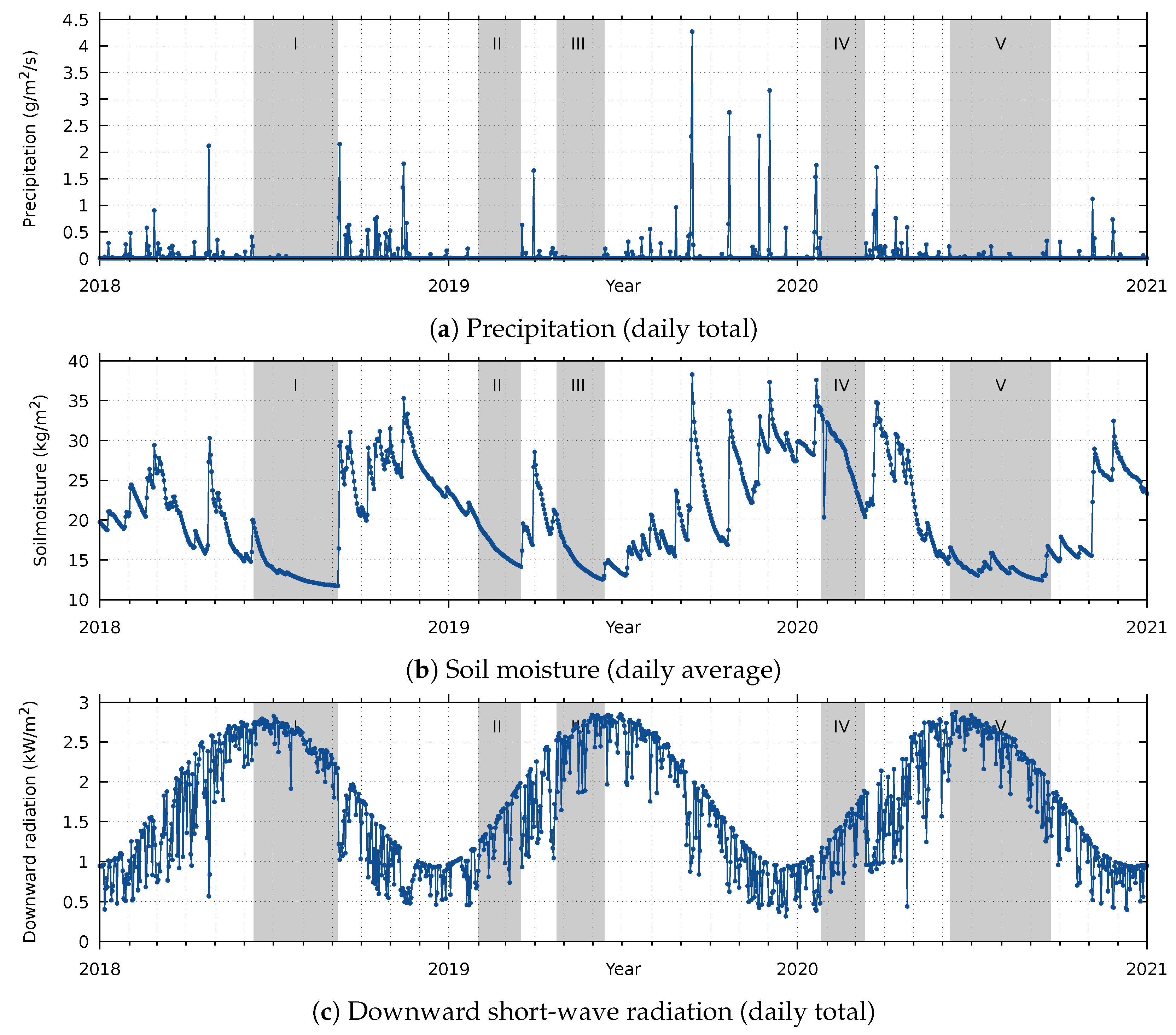
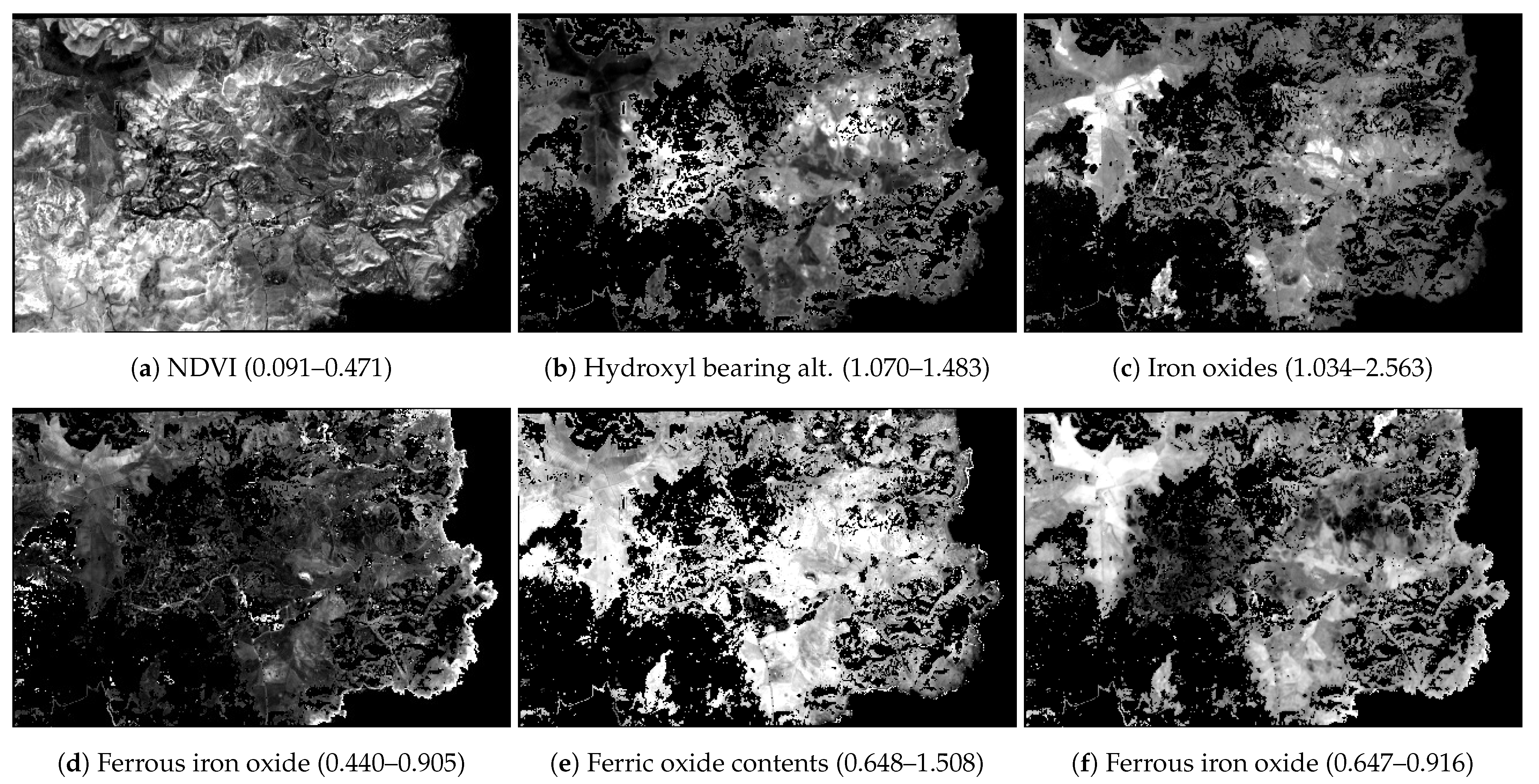


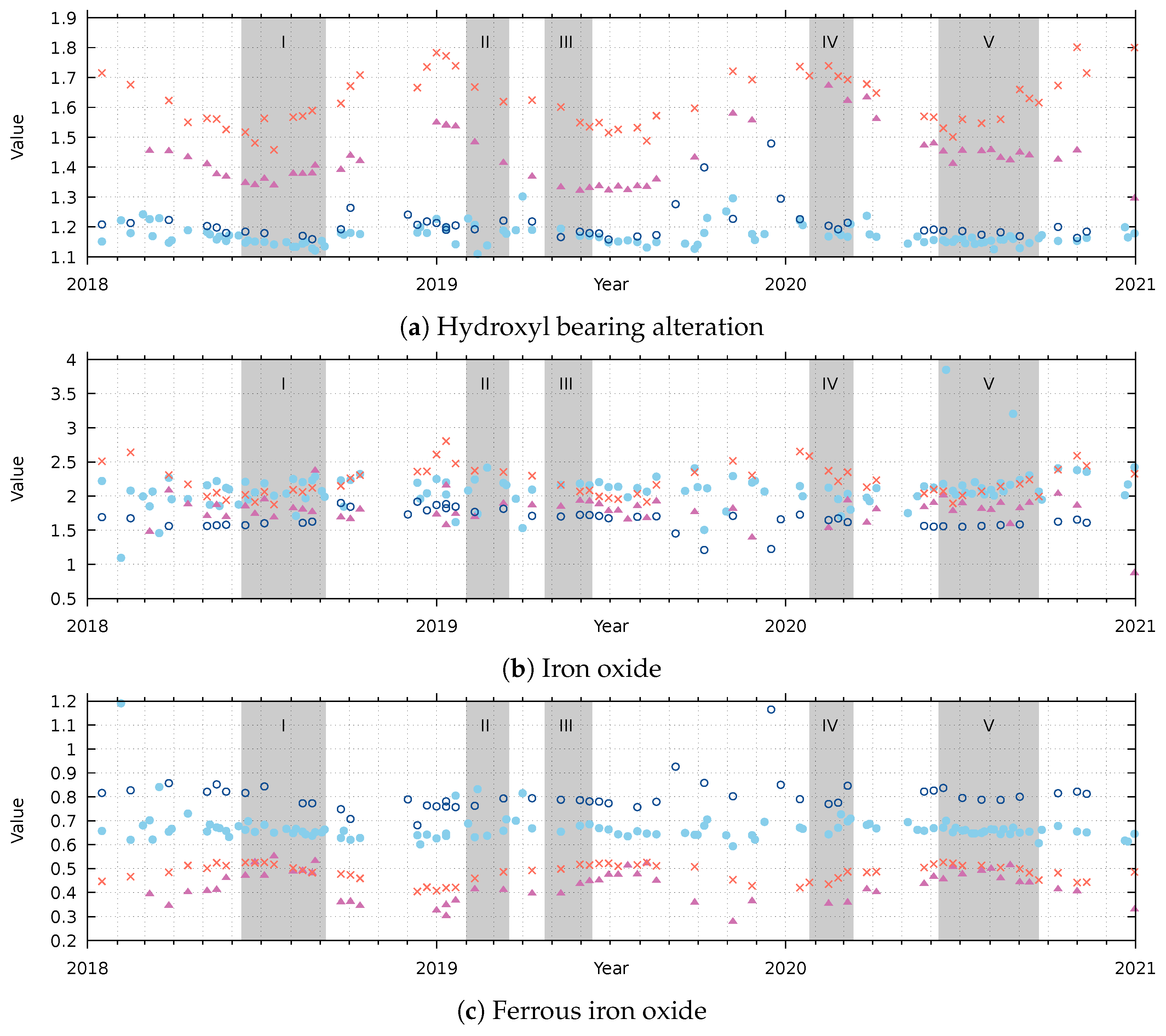

| Feature | Source | ASTER | Landsat TM | Sentinel-2 |
|---|---|---|---|---|
| NDVI | Huete [33] | (3−2)/(3+2) | (4−3)/(4+3) | (8−4)/(8+4) |
| Hydroxyl bearing alteration | Sabins [31] | 5/7 | 11/12 | |
| All iron oxides | 3/1 | 4/2 | ||
| Ferrous iron oxides | 3/5 | 4/11 | ||
| Ferric oxide contents, Fe | Cudahy [10] | 4/3 | 11/8 | |
| Ferric oxide composition, Fe | 2/1 | 4/3 | ||
| Ferrous iron index, Fe | 5/4 | 12/11 |
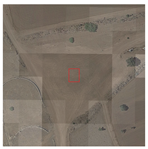 | Bare soil | 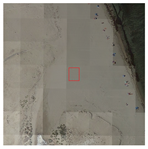 | Beach sand |
| 2.07455E, 36.86685N | 2.00555E, 36.85900N | ||
| 10 × 10 m. dirt road crossing, disturbed by infrequent traffic and therefore mostly kept bare. | 10 × 10 m. beach at a stream mouth, therefore occasionally wet and possibly disturbed by sunbathers. | ||
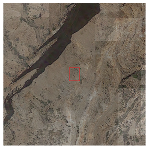 | Quarry floor | 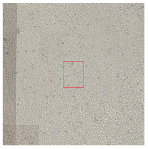 | Natural vegetation |
| 2.06125E, 36.85800N | 2.06239E, 36.86840N | ||
| 10 × 10 m. mix of rock, dirt and an occasional shrub. Unlikely to be disturbed over time but there may be shadows. | 20 × 20 m. mix of vegetation and natural soil. Unlikely to be disturbed over time but shows seasonal change. |
| Period | From | To | Length (days) | # Images |
|---|---|---|---|---|
| I | 11 Jun 2018 | 7 Sep 2018 | 88 | 8 |
| II | 1 Feb 2019 | 18 Mar 2019 | 45 | 5 |
| III | 24 Apr 2019 | 13 Jun 2019 | 50 | 5 |
| IV | 26 Jan 2020 | 12 Mar 2020 | 46 | 5 |
| V | 9 Jun 2020 | 22 Sep 2020 | 105 | 11 |
Publisher’s Note: MDPI stays neutral with regard to jurisdictional claims in published maps and institutional affiliations. |
© 2022 by the authors. Licensee MDPI, Basel, Switzerland. This article is an open access article distributed under the terms and conditions of the Creative Commons Attribution (CC BY) license (https://creativecommons.org/licenses/by/4.0/).
Share and Cite
van der Werff, H.; Ettema, J.; Sampatirao, A.; Hewson, R. How Weather Affects over Time the Repeatability of Spectral Indices Used for Geological Remote Sensing. Remote Sens. 2022, 14, 6303. https://doi.org/10.3390/rs14246303
van der Werff H, Ettema J, Sampatirao A, Hewson R. How Weather Affects over Time the Repeatability of Spectral Indices Used for Geological Remote Sensing. Remote Sensing. 2022; 14(24):6303. https://doi.org/10.3390/rs14246303
Chicago/Turabian Stylevan der Werff, Harald, Janneke Ettema, Akhil Sampatirao, and Robert Hewson. 2022. "How Weather Affects over Time the Repeatability of Spectral Indices Used for Geological Remote Sensing" Remote Sensing 14, no. 24: 6303. https://doi.org/10.3390/rs14246303
APA Stylevan der Werff, H., Ettema, J., Sampatirao, A., & Hewson, R. (2022). How Weather Affects over Time the Repeatability of Spectral Indices Used for Geological Remote Sensing. Remote Sensing, 14(24), 6303. https://doi.org/10.3390/rs14246303





